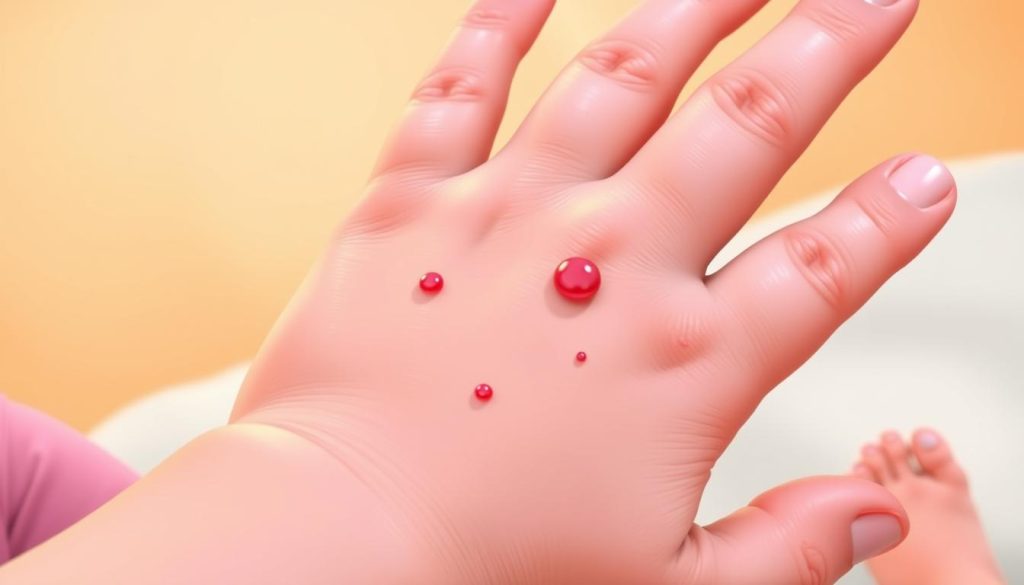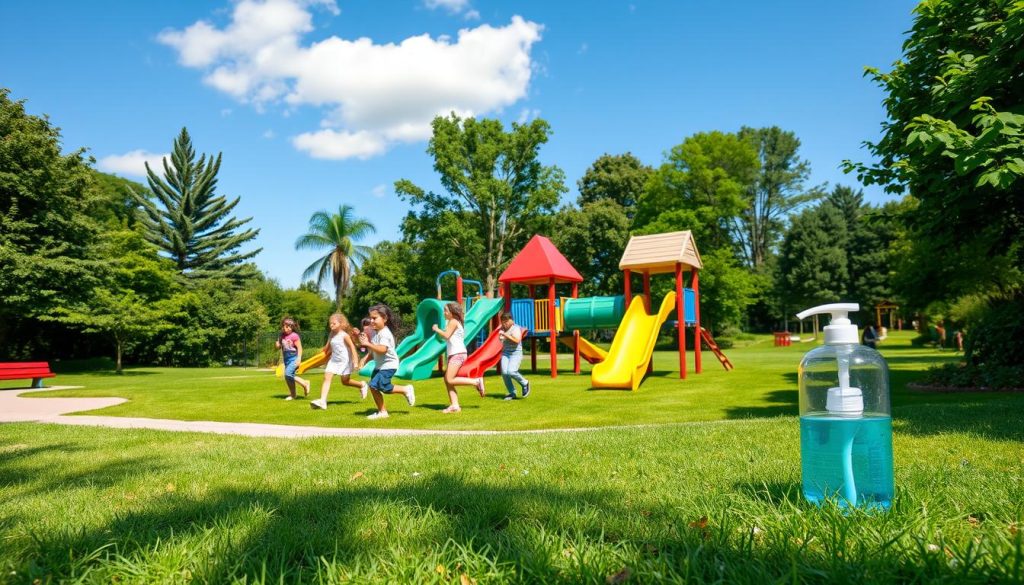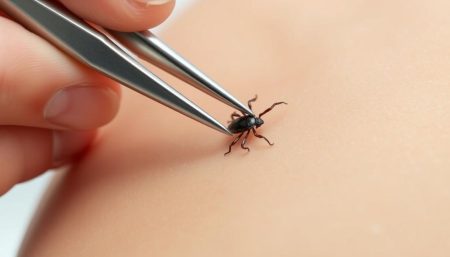Hand Foot and Mouth Disease (HFMD) is a big worry in places where kids are. It’s not just a minor issue; it’s a serious health concern. This article will help clear up when hand foot and mouth not contagious happens. We want to make sure those affected can safely join in with others again.
Knowing when HFMD infection period ends is key to stopping it from spreading. We’ll explain how to tell when it’s safe to be around others again. This is important to stop the disease and ease worries about it. We’ll focus on how it affects kids and adults, giving you important info about this common illness.
Understanding Hand Foot and Mouth Disease (HFMD)
Hand Foot and Mouth Disease (HFMD) is a common illness in kids but can hit adults too. Knowing how HFMD spreads and its symptoms is key to stopping it and treating it well.
What is HFMD?
HFMD is caused by viruses like Coxsackievirus A16 and Enterovirus 71, says the CDC. These viruses lead to mild to serious illness. People get sores in their mouth and a rash on their hands and feet.
Common Sources and Spread of HFMD
HFMD spreads through touching infected secretions or dirty surfaces. The WHO says it’s carried by nasal and throat fluids, saliva, blister fluid, or stool. Schools and daycare centers are hotspots because of the close contact and shared items.
This shows why good hygiene is vital to stop HFMD in places where lots of people are together. Spotting HFMD symptoms early helps keep it from spreading further.
Symptoms of Hand Foot and Mouth Disease in Children and Adults
Hand Foot and Mouth Disease (HFMD) is a common viral illness. It mainly affects HFMD in children but also adults. The symptoms can vary between these groups. Spotting the signs early helps manage the disease better and reduces discomfort.
Identifying Early Signs in Kids
Early HFMD signs in kids start with a fever and less appetite. They might also feel generally unwell. Soon, painful sores in the mouth and a rash on hands, feet, and sometimes buttocks appear. These symptoms are mild but can be very upsetting for young kids.
How HFMD Symptoms Present Differently in Adults
Yes, adults can get HFMD too. HFMD in adults shows different signs. Adults might have fever and sore mouth like kids. But the rash is often less noticeable or missing. They might also have more throat pain and feel more tired than kids.

| Age Group | Symptoms | Common Locations of Rash |
|---|---|---|
| Children | Fever, Mouth Sores, Rash, Appetite Loss | Hands, Feet, Buttocks |
| Adults | Fever, Sore Throat, Mouth Sores, Fatigue | Hands, Feet (less commonly on buttocks) |
When Is Hand Foot and Mouth Not Contagious
Knowing when someone is no longer contagious with Hand Foot and Mouth Disease (HFMD) is key. Experts say the virus can stay in body fluids even after symptoms go away. This means there’s a risk of passing it on.
The chance of spreading HFMD drops when the fever goes away and sores start to heal. But, the virus can stay in saliva, blister fluid, and stool for weeks. So, it’s important to know when someone is no longer contagious to stop more cases.
- Good hygiene is important all the time, not just when you’re sick.
- Watching for when blisters and sores disappear helps figure out when someone is safe again.
- Even after symptoms are gone, stool tests might show the virus is present.
Health experts say it’s okay to go back to normal activities when all blisters have dried and the fever is gone for 24 hours. This is without using medicines to lower fever.
While HFMD is very contagious, knowing when someone is no longer contagious helps. This knowledge is key to stopping the spread of the disease and keeping everyone safe.
Incubation Period and Duration of HFMD
Knowing the HFMD incubation period and duration of HFMD symptoms helps fight Hand, Foot, and Mouth Disease. This part talks about the time from getting infected to showing symptoms. It also looks at how different things can change how long someone is sick.
Initial Exposure and Symptom Onset
The time from getting infected to showing symptoms is usually 3 to 7 days. During this time, the virus grows inside the body but you won’t see any signs yet. The first signs are fever, sore throat, and feeling not well. Then, sores and rashes appear.
Factors Affecting HFMD Duration
How long someone has HFMD symptoms can really vary. Things like age, how strong your immune system is, and your overall health matter a lot. For example, younger kids often have symptoms longer because their immune systems are not as strong.
| Age Group | Average Duration of Symptoms |
|---|---|
| Children under 5 | 7-10 days |
| Older Children and Adults | 5-7 days |
It’s key for those taking care of sick people and doctors to know these times. This helps them support the sick better and stop the disease from spreading.
Isolation and Preventing the Spread of HFMD
Managing and stopping the spread of Hand Foot and Mouth Disease (HFMD) starts with isolation. Isolation for HFMD is key to controlling outbreaks and keeping everyone safe. We’ll look at steps both individuals and caregivers can take to stop this infection from spreading.
Quarantine Measures for Affected Individuals
When someone gets HFMD, it’s important to keep them away from others. They should stay isolated until their symptoms go away. This usually means they can’t go out until their fever is gone and their sores are healing.
- Stay at Home: Kids with HFMD should not go to school or daycare. Adults should also stay away from work and public places to prevent spreading the virus.
- Limit Contact Within Household: The sick person should have their own room and bathroom. This helps reduce contact with healthy family members.
- Personal Hygiene: Washing hands often with soap and water is a must for everyone in the house. This is very important after touching the sick person or their things.
Caregivers should also clean often-touched items like toys and phones. These items can carry the virus. Taking these steps is essential to stop HFMD from spreading and help the sick person get better faster.
Hand Foot and Mouth Disease: Recovery and Immunity
It’s important to know about HFMD recovery and immunity after HFMD. This helps in managing and predicting outcomes after getting sick. The recovery path varies but usually follows a pattern of symptom improvement. This is key for both caregivers and patients to watch.
What Does Recovery Look Like?
Recovery from Hand Foot and Mouth Disease means symptoms start to get better. People often see a drop in fever and pain within a week. But, it can take a bit longer for everyone, depending on their health and immune system.
Understanding Post-Recovery Immunity
After getting better from HFMD, people usually have temporary immunity to the virus they had. But, because there are many strains of the virus, getting sick again with a different strain is possible. It’s important to know this about immunity after HFMD.
| Stage of Recovery | Expected Improvements | Comments on Immunity |
|---|---|---|
| Initial Recovery (1-2 weeks) | Decrease in fever, sores begin to heal | Temporary immunity develops to the specific virus strain |
| Full Recovery (3-4 weeks) | Resolution of all symptoms, return to normal activities | Potential for reinfection with a different strain exists |
In summary, HFMD recovery usually means symptoms lessen in a couple of weeks and then go away. After getting better, it’s key to understand immunity after HFMD. This helps prevent getting sick again and sets the right expectations for future infections.
Treatment Options for Hand Foot and Mouth Disease
There’s no special HFMD treatment available, but managing symptoms is key. This helps ease discomfort and prevents more health issues. These steps are easy to do at home.
For those with HFMD, the goal is to lessen symptoms safely. Over-the-counter meds like acetaminophen or ibuprofen can help with pain and fever. But, kids should not take aspirin to avoid Reye’s syndrome.
Topical oral anesthetics are also good for mouth sores. They help reduce pain.
- Hydration: Essential to combat dehydration, which is hard when eating and drinking are painful.
- Rest: Enough rest helps the immune system fight the infection better.
- Lukewarm Baths: They can soothe rashes and lower fever.
- Mouthwashes or Sprays: These can numb mouth ulcers and give temporary pain relief.
Keeping well-hydrated is also very important. Drinking lots of fluids, like cold milk or water, can help mouth sores. Staying away from acidic or spicy foods is also good to avoid irritating mouth sores more.
Knowing and using these treatment options can help manage symptoms. It makes the recovery from HFMD more comfortable.
Supportive Home Care for HFMD Patients
Effective home care for HFMD is key to managing symptoms and speeding up recovery. This section covers comfort practices and dietary strategies for Hand Foot and Mouth Disease recovery.
Comfort Measures to Ease Symptoms
At home, managing HFMD symptoms mainly involves relief and preventing it from getting worse. Keeping affected areas clean and using cool compresses are important. Also, over-the-counter pain relievers can help.
Hygiene is critical, avoiding irritants and keeping a calm environment. This helps reduce discomfort from HFMD.
Nutritional Considerations During Recovery
Eating the right diet during HFMD recovery is vital. A soft, bland diet eases mouth pain and meets nutritional needs, even when appetite is low. Here’s a guide on what to eat:
| Meal | Recommendations | Benefits |
|---|---|---|
| Breakfast | Soft-scrambled eggs, oatmeal | Easy to consume; low irritation |
| Lunch | Broth-based soups, yogurt | Soothes oral ulcers, easy digestion |
| Dinner | Mashed potatoes, steamed vegetables | Nutrient-rich, soft texture |
| Snacks | Smoothies, apple sauce | Hydrating, soothing |
Using these dietary tips helps keep nutrient levels up and manage symptoms. This supports a full recovery from HFMD.
Seeking Medical Advice for HFMD
Managing Hand Foot and Mouth Disease (HFMD) in children requires knowing when to seek medical help. It’s key to know the typical symptoms and signs of serious health issues. We’ll look at when to get professional advice.
When to Consult Healthcare Professionals
Getting medical advice for HFMD is vital in some cases. If a child or adult has a high fever, unbearable pain, or severe symptoms, seek help. Also, if symptoms come back or get worse after getting better, it might be a sign of a secondary infection or other complications.
Recognizing Complications Requiring Urgent Care
Spotting complications early is critical for managing HFMD. Though rare, complications like viral meningitis can happen, as seen in The Lancet. Look out for severe headache, stiff neck, or unusual behavior, which mean urgent medical care is needed.
| Sign/Symptom | Normal Condition | Alarming Condition |
|---|---|---|
| Fever | Lasts 2-3 days | High fever persisting beyond 3 days |
| Rash | Red spots and sores without severe pain | Sores with intense pain or rapid spread |
| Behavior | Slight irritability | Extreme irritability, drowsiness or confusion |
| Hydration | Mild signs of dehydration | Signs of severe dehydration (no tears, very dry mouth, no urination for 8 hours) |
Watching for these signs and getting medical advice for HFMD can prevent complications. It helps in a smoother recovery. Always follow the advice of healthcare professionals who know about HFMD and its complications.
Prevention Strategies for Hand Foot and Mouth Disease
Stopping Hand Foot and Mouth Disease (HFMD) involves good hygiene and vaccines. These steps are key to fight the virus, mainly in places where it spreads a lot.
Effective Hygiene Practices to Reduce Risk
Keeping hands and places clean is vital against HFMD. Washing hands with soap and water often is a must, after touching someone sick or things kids touch a lot. Using hand sanitizers is also good when you can’t wash your hands.
- Cleaning and disinfecting things like toys and doorknobs with EPA-approved cleaners helps a lot.
- Don’t kiss, hug, or share food with someone with HFMD to stop it from spreading.
- People with symptoms should stay home to keep others safe.
Role of Vaccination and Outbreak Management
Vaccines are becoming a big help in fighting HFMD. They are mainly used in areas where the disease is common. These vaccines aim at viruses like EV71, which cause big outbreaks.
Vaccines have cut down on HFMD cases, including serious ones that need hospital care. Vaccination efforts in high-risk areas have shown to work well.
More research is needed to make vaccines better and more available. Supporting vaccine efforts and keeping up with good hygiene is key to beating HFMD worldwide.
Returning to School or Work After HFMD
After getting better from Hand Foot and Mouth Disease (HFMD), returning to activities post-HFMD needs careful planning. It’s important to follow rules for safely going back to HFMD in public settings. Here are steps and things to think about for going back to school or work after HFMD.
Listen to your doctor and local health rules to know when it’s okay to stop staying home. Usually, you can go back when your fever is gone and mouth sores start to heal. But, the virus might not be gone yet, so it’s key to keep taking precautions to stop it from spreading.
- Make sure all symptoms are gone before returning to activities post-HFMD.
- Keep up with good hand hygiene, like washing hands often.
- Stay away from activities where you might share saliva or secretions.
- Disinfect things you touch a lot, like doorknobs and phones.
- Watch for any signs of symptoms coming back and talk to a doctor if you’re worried.
Knowing when and how to go back to places like work or school can be helped by health advice. Look at detailed guidelines on managed healthcare settings. They offer ways to keep safe while also doing important things.
| Activity | Guidelines Post-HFMD |
|---|---|
| School Attendance | Return once fever-free without medication for 24 hours and blisters begin to dry up. |
| Office Work | Return after all sores have healed, and hand hygiene protocols are established. |
| Public Transport Use | Use with caution, avoid during peak times, and practice enhanced hand hygiene. |
| Gym Attendance | Resume after symptomatic recovery and maintain rigorous cleaning of equipment. |
Following these steps helps in returning to activities post-HFMD safely. It also keeps the community safe from HFMD. By being careful, people can go back to their daily lives easily, keeping themselves and others healthy.
Hand Foot and Mouth Disease Vs. Other Illnesses
Hand Foot and Mouth Disease (HFMD) can look like other viral and bacterial infections. It’s important to know how to tell HFMD apart from other illnesses. This part explains how to spot HFMD and what makes it different from other diseases.
Differential Diagnosis of Similar Symptoms
HFMD mainly hits kids and shows up as mouth sores and a rash on hands and feet. But, chickenpox and herpangina can look similar but are different. Herpangina mainly affects the throat, not the hands and feet, which helps tell HFMD apart. Doctors need to watch closely and sometimes test to make a correct diagnosis.
Key Differences Between HFMD and Other Diseases
HFMD, chickenpox, and other viruses can all cause rashes and fever. But, there are clues that help tell HFMD apart. For example, HFMD rash doesn’t turn into itchy blisters like chickenpox does. Also, chickenpox rashes cover more areas. Knowing these differences helps manage the illness better and reduces worry.
For more on managing symptoms, check out this article on face allergy symptoms. It offers more insights on telling different conditions apart.
Being able to spot unique signs of HFMD is key. Parents and caregivers should see a doctor if they think their child has HFMD. This ensures kids get the right treatment based on a correct diagnosis.
Debunking Myths About Hand Foot and Mouth Disease
To better understand Hand Foot and Mouth Disease (HFMD), it’s key to separate fact from fiction. This section aims to clear up common misconceptions about HFMD. We’ll use evidence-based information to do so.
Sifting Fact from Fiction in HFMD Information
Many myths about HFMD spread, causing worry or wrong actions. We’ll address some of these myths and replace them with true facts.
| Myth | Truth |
|---|---|
| HFMD only affects children. | Though more common in children, adults can also contract HFMD. This is true if they haven’t been exposed before or have a weak immune system. |
| HFMD is always a mild disease. | While usually mild, HFMD can sometimes cause serious problems. This includes viral meningitis or encephalitis, mainly in young children. |
| Once recovered, you can’t get HFMD again. | Reinfection is possible. This is because different strains of the Coxsackievirus and Enterovirus can cause HFMD. |
| You can only contract HFMD in the summer. | HFMD cases peak in summer and fall. But, infections can happen any time of the year. |
| HFMD spreads solely through saliva. | HFMD spreads through direct contact with saliva, fluid from blisters, or feces. Good hygiene is key to prevent the virus. |
Understanding HFMD truths means relying on scientifically accurate info. By debunking these myths, we help reduce stigma. We also promote better prevention and management of the disease.
Stigma and Misconceptions Surrounding HFMD
Hand Foot and Mouth Disease (HFMD) is often misunderstood, leading to HFMD stigma. This stigma affects those who have the disease and their families. The main reason for this stigma is a lack of knowledge about HFMD.
Many people believe HFMD comes from poor hygiene. This belief can make those with HFMD feel judged and left out. But, the truth is, anyone can get HFMD, no matter how clean they are.
HFMD is sometimes mixed up with other illnesses because of similar symptoms. But, HFMD is a unique virus with its own signs and patterns. Another myth is that only kids get HFMD, when in fact, adults can also be affected.
This misunderstanding can lead to delayed treatment for adults. It also makes it harder for people to get support from their communities.
To fight HFMD stigma and clear up myths, we need to educate the public. Schools, hospitals, and media can help spread the right information. By learning about HFMD, we can create a more supportive environment for those affected.
When communities are well-informed, they can offer kindness instead of judgment. This helps in reducing the stigma around Hand Foot and Mouth Disease.
FAQ
Q: What is Hand Foot and Mouth Disease (HFMD)?
A: Hand Foot and Mouth Disease (HFMD) is a common illness in kids. It’s caused by viruses like Coxsackievirus A16 and Enterovirus 71. Symptoms include fever, mouth sores, and a skin rash.
Q: How is HFMD transmitted?
A: HFMD spreads through contact with an infected person’s saliva, blister fluid, stool, or respiratory secretions. It often hits places with lots of young kids, like daycare centers or schools.
Q: What are the initial signs of HFMD in children?
A: Early signs in kids include fever, less appetite, feeling tired, and sore throat. Then, painful sores in the mouth and a rash on hands and feet appear.
Q: Do HFMD symptoms present differently in adults?
A: Yes, adults might have milder symptoms or show no signs at all. But they can spread the virus to others, including kids who are more likely to get sick.
Q: When is an individual with HFMD no longer contagious?
A: Someone with HFMD is usually most contagious in the first week. But the virus can stay in the body and spread for weeks after symptoms go away. Health experts can give specific advice on when it’s safe to stop spreading the virus.
Q: What is the incubation period for HFMD?
A: The incubation period for HFMD is usually 3-6 days from when you first get infected to when symptoms start.
Q: How can the duration of HFMD symptoms vary?
A: Symptoms can last differently for everyone, based on how well your body fights the virus and the virus type. Symptoms usually last 7 to 10 days.
Q: What isolation measures should be taken for someone with HFMD?
A: Keep the sick person at home, away from school, daycare, or work. Wait until fever goes down and mouth sores start to heal to stop spreading it to others.
Q: What does recovery from HFMD look like?
A: Recovery means symptoms slowly get better. Sores heal, rash fades, and fever goes down. This usually takes 7-10 days.
Q: Is there immunity to HFMD after recovery?
A: After getting better, you’re immune to the specific virus that made you sick. But because there are many viruses that can cause HFMD, you can get it again from a different one.
Q: How is Hand Foot and Mouth Disease treated?
A: Treatment for HFMD mainly helps manage symptoms. Use over-the-counter pain relievers, topical oral anesthetics for sores, and stay hydrated and rested at home.
Q: What home care measures can help someone with HFMD?
A: To feel better, keep your mouth clean, use ointments on rashes, and eat soft foods. This helps with mouth sores.
Q: When should a person seek medical attention for HFMD?
A: See a doctor if symptoms get worse, like a high fever, a lot of pain, dehydration signs, or new symptoms. It’s important to get help if you’re worried.
Q: How can Hand Foot and Mouth Disease be prevented?
A: Preventing HFMD includes washing hands often, cleaning surfaces, avoiding close contact with sick people, and keeping good hygiene.
Q: What guidelines should be followed before returning to school or work after HFMD?
A: Wait until fever is gone and blisters have dried up before going back to school or work. Always follow health expert advice on when it’s safe to return.
Q: How can HFMD be distinguished from other similar illnesses?
A: HFMD can be told apart by fever, mouth sores, and a rash on hands and feet. This helps distinguish it from chickenpox or herpangina.
Q: What are some myths about Hand Foot and Mouth Disease?
A: Some myths say HFMD only affects kids (it can also hit adults) or that you can’t get it again. Each case needs accurate info and guidance.
Q: How can stigma and misconceptions about HFMD be addressed?
A: Fighting stigma and myths about HFMD starts with education and sharing true facts. Knowing it’s a common, usually mild illness helps reduce fear and promotes kindness.


















